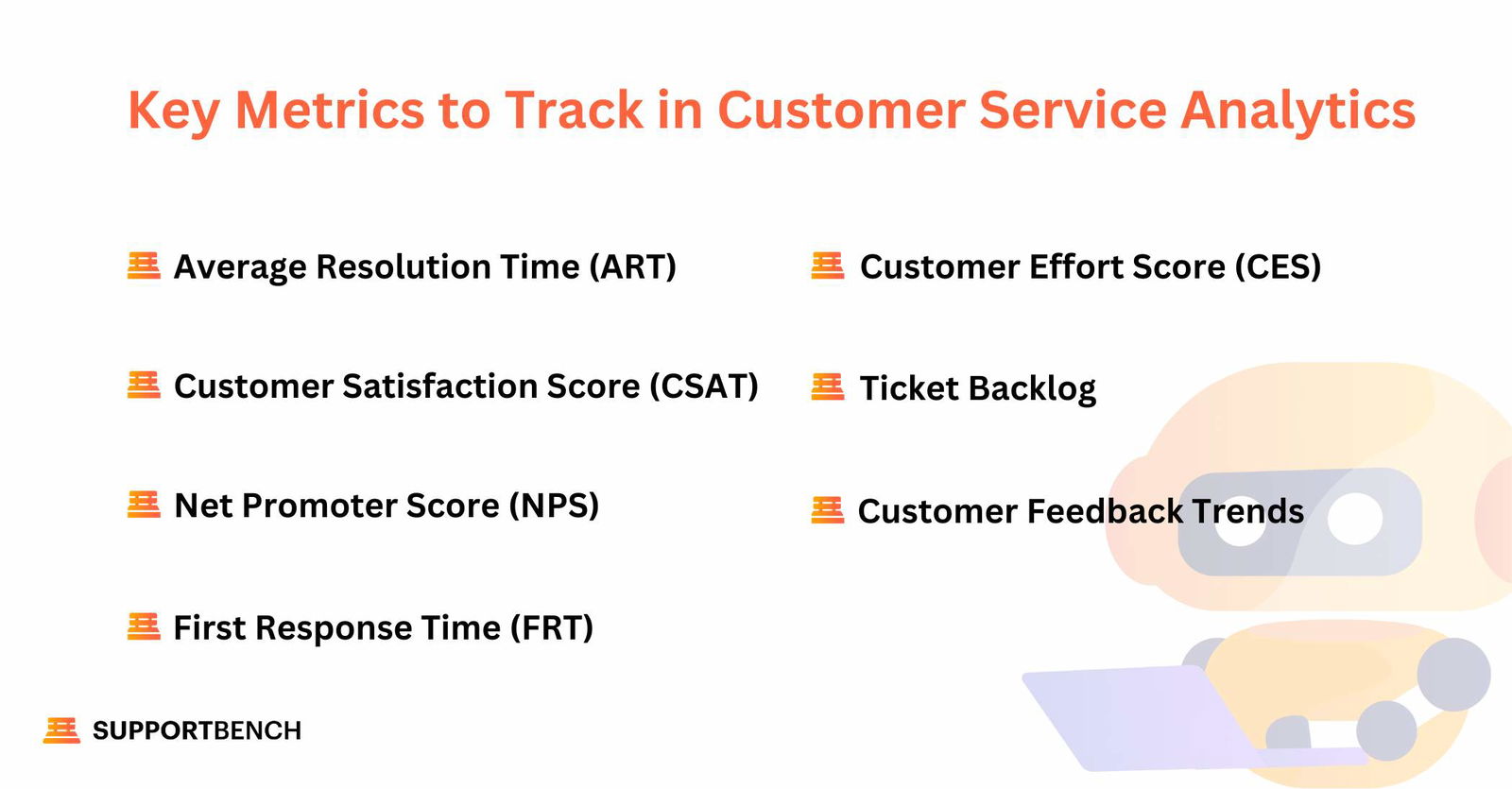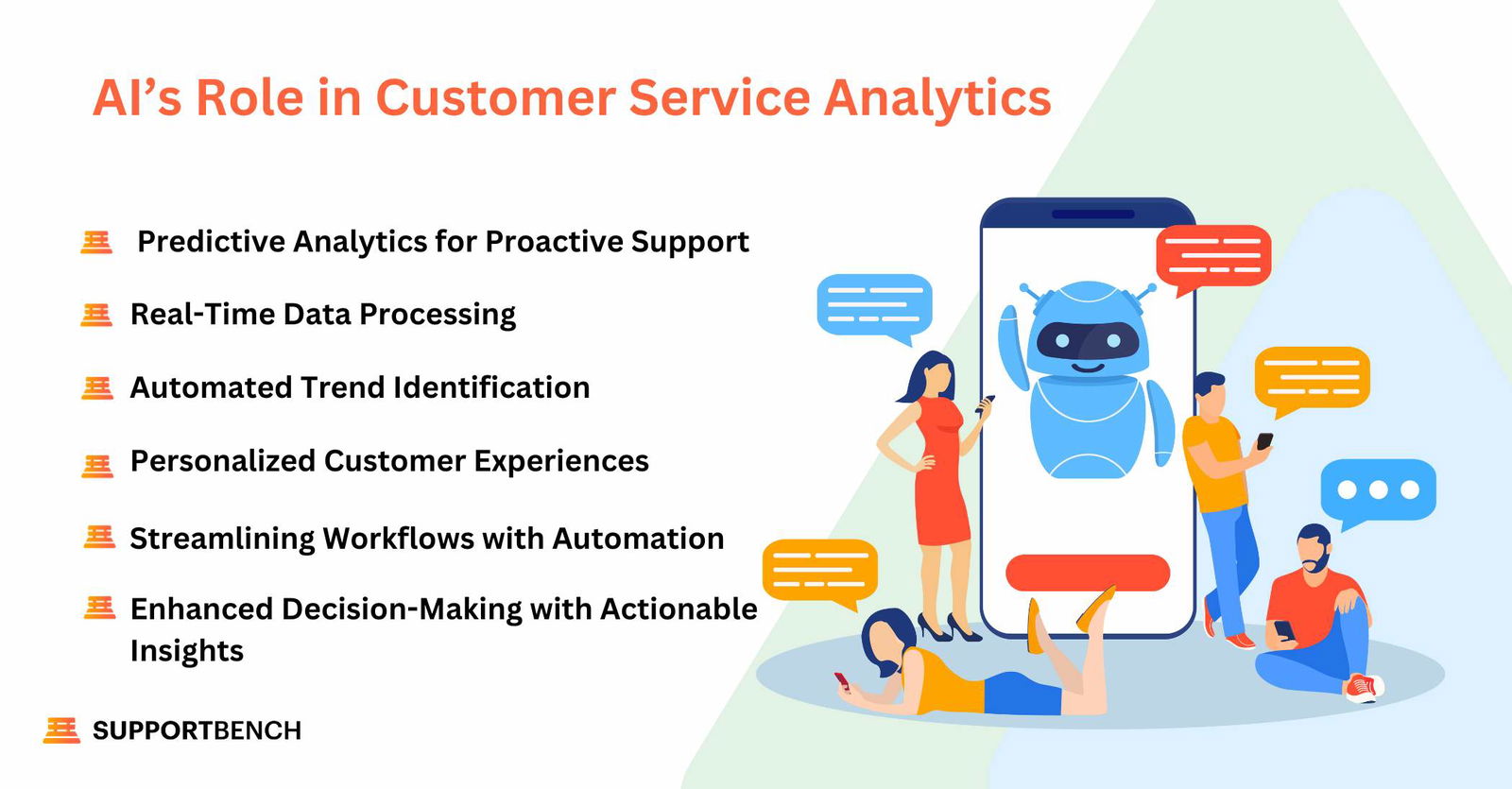Customer service analytics transforms business operations by providing insights that enhance decision-making, improve customer satisfaction, and increase efficiency.
By tracking key metrics such as resolution times, satisfaction scores, and customer feedback, organizations can refine their strategies to deliver exceptional support. Leveraging AI-powered analytics and customizable dashboards, businesses can turn data into actionable solutions, driving better outcomes for both SMBs and enterprises.
What is customer service analytics, and why is it important?
Customer service analytics involves collecting, measuring, and analyzing data from customer interactions to improve decision-making and enhance business outcomes.
By leveraging customer service analytics tools, companies can track essential metrics such as resolution times, customer satisfaction scores, and feedback trends to identify areas for improvement.
This data-driven approach helps organizations move beyond guesswork, ensuring that every decision is backed by actionable insights. For example, analytics can pinpoint bottlenecks in service workflows, highlight team productivity gaps, and identify recurring customer complaints, allowing businesses to take proactive corrective actions.
Customer service analytics transforms raw data into valuable insights that help businesses:
- Understand customer behavior and preferences.
- Monitor key performance indicators (KPIs) to optimize operations.
- Enhance customer satisfaction by addressing pain points.
- Drive long-term loyalty and retention through better service experiences.
Implementing customer service analytics is essential in today’s competitive landscape. SMBs can use analytics to maximize limited resources, while larger enterprises can leverage AI-driven insights to manage complex workflows and achieve strategic goals.
What metrics are most important for customer service analytics?
Tracking the right metrics is essential for evaluating and improving customer support effectiveness. These key customer service metrics provide insights into performance, customer satisfaction, and areas requiring improvement.
Below are some of the most critical metrics to include in your customer service analytics strategy:

Average Resolution Time (ART)
This metric measures the average time required to resolve customer issues. Shorter resolution times typically indicate efficient workflows and higher customer satisfaction. By analyzing ART, businesses can identify bottlenecks and implement solutions to improve response speed.
Customer Satisfaction Score (CSAT)
CSAT is one of the most widely used metrics to gauge customer satisfaction with a specific interaction or service experience. It is collected through post-service surveys, helping businesses track customer sentiment over time and identify trends.
Net Promoter Score (NPS)
NPS assesses customer loyalty by asking, “How likely are you to recommend our service to others?” Scores categorize respondents as Promoters, Passives, or Detractors, providing insights into overall brand perception and areas for improvement.
First Response Time (FRT)
FRT measures how quickly a support team responds to initial customer inquiries. A low FRT demonstrates responsiveness and respect for customer time, which directly impacts satisfaction.
Customer Effort Score (CES)
CES evaluates how easy it is for customers to resolve their issues. Lower effort scores indicate well-designed support processes and greater customer satisfaction.
Ticket Backlog
This metric tracks the number of unresolved tickets at any given time. A growing backlog may signal resource shortages or inefficient workflows, requiring immediate attention.
Customer Feedback Trends
Analyzing trends in customer feedback, such as recurring complaints or positive reviews, provides deeper insights into what is working well and what needs improvement in service operations.
How does AI enhance customer service analytics?
AI and automation are revolutionizing customer service analytics by enabling businesses to predict trends, identify issues early, and optimize operations.
By integrating AI-driven analytics into customer support, organizations can gain deeper insights and make more data-driven decisions. Here’s how AI plays a critical role:

Predictive Analytics for Proactive Support
AI-powered systems analyze historical data to forecast future trends, enabling businesses to anticipate spikes in customer inquiries, identify potential pain points, and allocate resources effectively before problems arise.
For example, predictive analytics can detect patterns in ticket volumes during seasonal peaks, allowing teams to prepare in advance.
Real-Time Data Processing
AI systems process vast amounts of real-time data, providing immediate insights into customer behavior and service performance. This allows businesses to respond quickly to emerging trends, improving responsiveness and customer satisfaction.
Automated Trend Identification
With AI, businesses can uncover hidden trends in customer interactions. Natural language processing (NLP) tools analyze chat transcripts and email exchanges to identify recurring issues or shifts in customer sentiment. These insights enable teams to address root causes efficiently.
Personalized Customer Experiences
AI-driven analytics tools segment customers based on behavior, preferences, and past interactions. This data helps businesses deliver tailored solutions, enhancing customer loyalty and satisfaction. For instance, AI can suggest personalized responses or escalate complex cases to senior agents.
Streamlining Workflows with Automation
Automation simplifies repetitive tasks such as ticket categorization, routing, and status updates. This reduces the workload on human agents, allowing them to focus on resolving complex issues. Automated systems also ensure consistency and accuracy in customer support processes.
Enhanced Decision-Making with Actionable Insights
AI provides actionable insights through intuitive dashboards and reports, helping leaders track key metrics and assess team performance. Real-time analytics enable businesses to make data-driven decisions that improve outcomes.
By leveraging AI-driven analytics for customer support, businesses can revolutionize customer service processes, delivering faster, more efficient, and highly personalized experiences. AI is no longer just a tool; it is a strategic partner in achieving superior customer satisfaction and operational excellence.
Real-World Impact: How Analytics Drive Better Customer Support Outcomes
Real-world applications of customer service analytics tools demonstrate how data-driven insights can transform decision-making and improve outcomes.
Let’s explore a case study that highlights how analytics and automation are helping businesses like Payfirma enhance their customer support operations.
Case Study: Payfirma Transforms Customer Support with Analytics
Payfirma, a fintech company specializing in payment processing, supports nearly 10,000 customers across Canada and the U.S. Despite having a small support team of four, they manage a monthly caseload of 800–1,000 cases.
The challenge was clear: they needed a robust solution to improve efficiency and customer satisfaction while maintaining high-quality support.
By adopting Supportbench’s advanced analytics tools, Payfirma’s support team achieved significant operational improvements:
- Enhanced team visibility and metrics tracking: The Director of Operations uses Supportbench’s Command Centre to monitor real-time team progress. This dashboard provides an actionable overview of case statuses, ensuring accountability and efficiency.
- Streamlined workflows: Supportbench simplified processes such as case merging and routing. Features like adding screenshots to cases help agents save time while improving customer communication.
- Improved response and resolution times: With real-time case monitoring and push notifications, the team reduced their average resolution time by half a day and improved first response times, leading to higher customer satisfaction.
This case study highlights how leveraging customer service analytics tools improves operational decision-making and enhances customer experiences by delivering faster and more efficient support.
By implementing data-driven strategies and solutions, businesses like Payfirma demonstrate the power of analytics in optimizing resources, improving team performance, and ultimately enhancing customer satisfaction.
How to Implement Customer Service Analytics Effectively
Implementing customer service analytics may seem complex, but with the right steps, tools, and strategies, it becomes manageable and highly impactful. Here’s a practical guide to successfully integrating analytics into your customer service operations.

Define Clear Goals and KPIs
Before implementing analytics, identify your objectives. Are you aiming to reduce resolution times, increase customer satisfaction, or identify service bottlenecks?
Align these goals with measurable key customer service metrics, such as:
- Average Resolution Time (ART): Tracks how quickly tickets are resolved.
- CSAT (Customer Satisfaction Score): Gauges customer satisfaction.
- NPS (Net Promoter Score): Measures customer loyalty and likelihood of referrals.
Setting well-defined KPIs ensures your analytics efforts remain focused and actionable.
Select the Right Tools
Choose robust customer service analytics tools with advanced capabilities such as:
- Dashboards for real-time KPI tracking
- AI-driven analytics for trend identification and predictive insights
- Integration with business tools for seamless data sharing across platforms
Solutions like Supportbench combine these features to make analytics more accessible and efficient.
Invest in Team Training
Your team needs to understand how to interpret and apply analytics to improve decision-making. Conduct training sessions or workshops to familiarize them with analytics tools and processes. Empowering agents with data-driven knowledge fosters confidence and enhances performance.
Focus on Data Collection and Cleanliness
Accurate data is the foundation of meaningful insights. Ensure your system captures critical information such as ticket resolution times, customer feedback, and scalation patterns. Regularly audit and clean your data to prevent inaccuracies and maintain reliability.
Implement AI and Automation
AI-driven analytics can automate routine tasks and uncover actionable trends. AI-powered predictive analytics helps businesses anticipate customer needs, allocate resources efficiently, and proactively resolve potential issues.
Continuously Monitor and Refine
Analytics is an ongoing process. Regularly review performance data and adjust strategies to align with business goals. Dashboards make it easy to track trends, identify gaps, and pivot strategies as needed.
The Business Impact of Customer Service Analytics: Efficiency, Satisfaction, and Profitability
Customer service analytics goes beyond tracking team performance—it directly improves efficiency, customer satisfaction, and profitability. By leveraging predictive analytics for customer service, businesses can optimize key areas and drive measurable results.
Let’s explore how analytics can deliver meaningful improvements:
Improving Efficiency
One of the most significant benefits of customer service analytics is enhanced operational efficiency. By tracking key metrics such as resolution times, response rates, and agent productivity, businesses can identify inefficiencies and streamline workflows.
Supportbench’s advanced analytics tools provide a comprehensive view of agent performance, helping businesses pinpoint bottlenecks and optimize service delivery.
AI-driven insights and reports also automate routine processes, reducing manual work and allowing support teams to focus on more complex customer issues. This leads to faster response times, quicker resolutions, and a more efficient service experience.
Boosting Customer Satisfaction
Customer service analytics provide valuable insights into customer pain points and service gaps. Metrics like CSAT, NPS, and customer feedback reveal how customers perceive their support experience, allowing businesses to make necessary improvements.
Supportbench’s customizable KPI-tracking dashboards help businesses visualize satisfaction metrics in real time, making it easier to address issues promptly and enhance service quality.
With AI-driven insights, support teams can anticipate customer needs and provide personalized service, increasing customer satisfaction and loyalty. By continuously monitoring customer sentiment, businesses can maintain a seamless and satisfying customer experience, ultimately improving retention and advocacy.
Enhancing Profitability
Effective customer service analytics not only improve customer interactions but also drive better business outcomes. By optimizing team efficiency and increasing customer satisfaction, businesses can directly impact profitability.
With SLA management and escalation analytics, businesses can ensure that high-priority cases are handled promptly, preventing delays that could harm customer relationships and revenue.
AI-driven insights also help uncover upselling and cross-selling opportunities, allowing businesses to generate additional revenue through targeted and timely support interactions.
In conclusion, leveraging customer service analytics with tools like Supportbench’s advanced analytics helps businesses lower operational costs, increase customer lifetime value, and create a more profitable service operation.
Conclusion
Leveraging customer service analytics is essential for improving efficiency and customer satisfaction. By tracking key metrics like resolution times, CSAT, and NPS, businesses can make informed, data-driven decisions that enhance service quality and outcomes.
With Supportbench’s advanced analytics tools, SLA management, and customizable dashboards for service teams, your team can quickly identify trends, streamline workflows, and deliver superior customer experiences.
Ready to elevate your customer service? Start utilizing analytics to achieve better results. Get started with Supportbench today!












